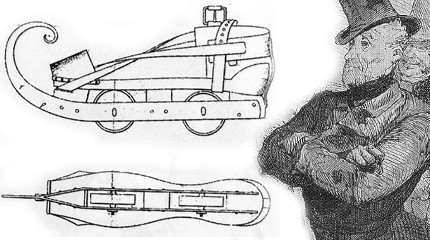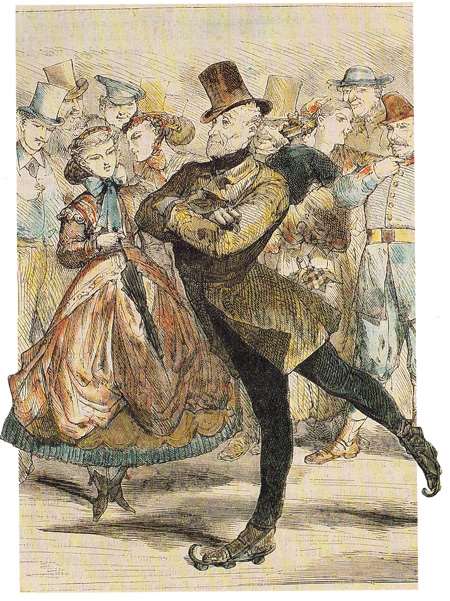Louis Legrand (France): From the butcher shop to roller skating
Legrand's career is very special. As an educated butcher, he invented a roller skate, which the German composer Giacomo Meyerbeer used for his opera "the prophet"...
Par alfathor

Biography of Louis Legrand (? – 1869)
 You can say that Louis Legrand has provided many mysterious moments in his life and that a lot has been written about it. One could almost speak of a double life: on the one hand he lived as the “unknown of the Place de la Concorde” (aka Constant) and on the other he was the true Legrand. He followed the interests of journalist Pierre Vérin, who assisted in many publications.
You can say that Louis Legrand has provided many mysterious moments in his life and that a lot has been written about it. One could almost speak of a double life: on the one hand he lived as the “unknown of the Place de la Concorde” (aka Constant) and on the other he was the true Legrand. He followed the interests of journalist Pierre Vérin, who assisted in many publications.
Legrand and Constant: one single person!
In many publications, one might think that Constant “the unknown” who skates on the Place de la Concorde, is not the same person as Legrand. Robert Ignatius Letellier reports that the skating of Legrand inspired Meyerbeer. Sam Nieswizski witnessed the same thing. Constant had made a habit of strolling across the Place de la Conocrode with his roller skates. The venue is located near the Champs-Elysées, where Meyerbeer lived.
Pierre Véron described the stranger of the Place de la Concorde as follows:
Perre Verron in “Comédie en plein vent”. P. 83 to p. 86 from 1866
The roller skate by Louis Legrand
In 1848, Louis Legrand invented a roller skate with two double wheels placed on a likewise split ice frame. This construction offered more stability for beginners. Even today, you can still find a few copies in private exhibitions, albeit rarely.
The encounter between skater Louis Legrand and composer Giacomo Meyerbeer
Pierre Véron in “Comédie en plein vent”. P. 83 to p. 86 from 1866
Louis Legrand/ Constant demonstrated his invention in public. Giacomo Meyerbeer watched him and planned a carnival sequence on ice for his grand opera in the fifth act: “the prophet”. Shortly before the premiere, he added a ballet by playing a scene in act 3 with skaters. He asked Louis Legrand for help. In the archives you can even find traces to the recompense of Legrand. His job was to provide and maintain the material. He also trained the ballet.
The failure of the skating rink
In 1849 Legrand founded a skating rink with an asphalt floor. You can find this information in the “Le Ménestrel: journal de musique” from the November 1849:
“We still recommend the amateurs to enjoy the fun and enjoyment of skating in the gymnase des patineurs in the rue du Banquet, near the Champs-Elysées. This great invention by M. Legrand is permanent.”
Unfortunately, the newspaper was wrong. (Sam Nieswizski, 1991).
In the newspaper “Le Tintamarre” on the 25.08.1850 the reopening of the gymnase des patineurs was announced in his former restaurant, in the 36 rue du Banquet, for 09.09.1850. The review “The fashion: overview of fashions, gallery of morality, albums of salons” specified on 05.01.1851:
“The reopening of the gymnase des patineurs will take place on Saturday the 24th” (January 1851). In the “Le Nouvelliste” one could read on 17.01.1852 that the reopening would take place on Monday, 19.02.1852.
Well, the place seems to have opened and closed several times. Unless one assumes that there have been several homonymous places.
“He tells of the brilliance and of the decay of the gymnase des patineurs, it is an institution to which he dedicated his life and he had the misfortune to see how it died.”
Pierre Véron in “Comédie en plein vent” p. 83 to p. 86 from 1866
The end of Louis Legrand
“Le Monde Illustré” on 23.04.1870 describes the sinking of the skating rink and the death of its founder by Pierre Veron:
“A paragraph about the rising of the gymnase des Patineurs, a fiasco from the past, but which still seems to me to be up to date in my opinion. This building was the invention of a brave monomaniac that we saw on skates at 40 degrees Celsius on the Place de la Concorde. May God rest his soul!
The “Journal des Coiffeurs” published a report on the defeat and death of Constant on 01.09.1874:
“His death is his own fault, the gymnase des Patineurs ruined his life; he died of an inflammation in his chest, which is due to his profession. “
Giacomo Meyerbeer died five years before Legrand, on 02.05.1864 in Paris.
“Le ballet des patineurs” by Giacomo Meyerbeer
useful links
Giacomo Meyerbeer : a reader – publié par Robert Ignatius Letellier
